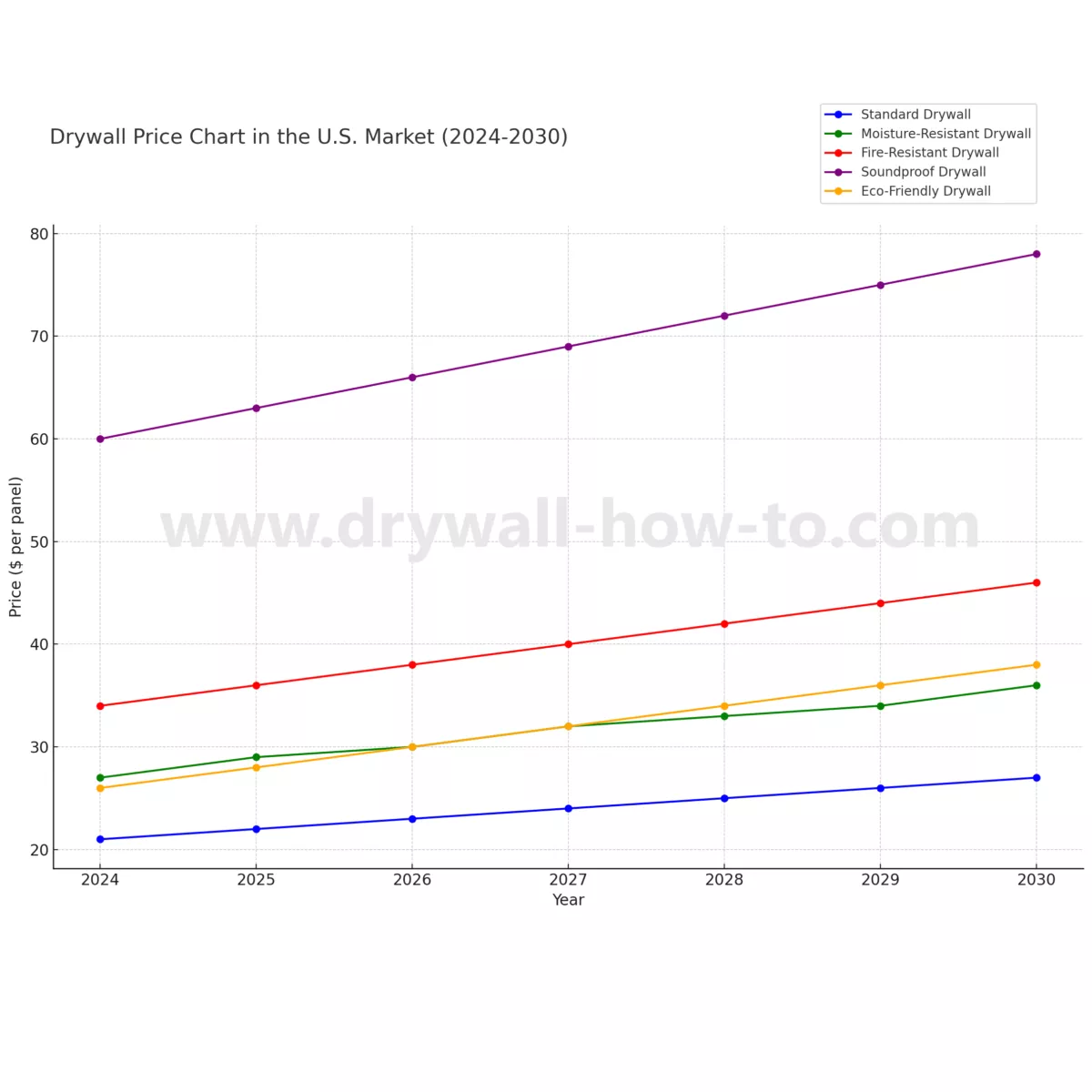Comprehensive Analysis of Drywall Price Charts in the USA: Types, The manufacturer plays a crucial role in determining the cost per square foot of drywall products.s, Sellers, and Market Trends
Drywall, also known as gypsum board or sheetrock, is a crucial component in the construction and renovation industry. It is used to create walls and ceilings in residential, commercial, and industrial buildings. The demand for drywall in the USA has been consistent due to the ongoing growth of construction projects, ranging from new homes to renovation works. Understanding drywall prices, the factors influencing them, and the role of manufacturers and sellers in the market can provide valuable insights to contractors, builders, and homeowners.
Purpose of the Article
This article aims to provide a comprehensive analysis of drywall prices in the USA. It will focus on various types of drywall, compare manufacturers and sellers, and analyze market trends, including production, sales, demand, and pricing. Additionally, the article will provide detailed tables, graphs, and insights into wholesale and retail pricing. By the end of this article, readers will be equipped with the knowledge to make informed decisions when purchasing drywall for their projects.
Structure of the Article
This article is structured into several key sections:
- Types of drywall and their characteristics.
- Major drywall manufacturers in the USA.
- Major drywall sellers in the USA.
- Drywall price analytics.
- Market trends, including production, sales, and demand.
- Detailed tables and graphs for drywall prices, manufacturers, sellers, and trends.
Types of Drywall
There are several types of drywall available in the USA market, each designed for specific purposes. The cost to install drywall and the drywall installation price vary depending on the type of drywall chosen. Below are the most common types:
Standard Drywall has an average drywall thickness that is commonly used in residential projects.
Description: A cost guide for finish drywall options. Standard drywall is the most commonly used type of drywall in construction projects. It consists of a gypsum core sandwiched between two sheets of paper. It is used in a variety of applications, from residential to commercial buildings.
- Thickness: Typically ranges from ½ inch to 5/8 inch.
- Fire Resistance: Standard drywall offers minimal fire resistance but can be used in most rooms of a house.
- Price Range: $12 – $20 per panel (4’x8’).
Moisture-Resistant Drywall is often preferred by drywall contractors for its durability. (Green Board)
Description: This type of drywall is designed for use in moisture-prone areas such as bathrooms, kitchens, and basements. It contains water-resistant materials to prevent mold growth.
- Features: Moisture-resistant, but not entirely waterproof.
- Price Range: $15 – $25 per sheet.
- Applications: Ideal for humid areas like bathrooms or kitchens.
Fire-Resistant Drywall (Type X)
Description: Fire-resistant drywall is used in areas where fire protection is a priority, such as garages and furnace rooms. It is thicker and contains glass fibers to help slow the spread of fire, making it an excellent choice for moisture-resistant drywall finish.
- Fire Rating: Typically rated for 1 hour of fire protection.
- Price Range: $20 – $30 per panel.
- Applications: Commercial buildings, garages, and areas with higher fire risks.
Soundproof Drywall
Description: Soundproof drywall is designed to reduce noise transmission between rooms. It is typically thicker and heavier than standard drywall and contains sound-dampening materials.
- Sound Attenuation: Ideal for offices, home theaters, and apartment buildings.
- Price Range: $30 – $60 per panel.
- Applications: Areas requiring noise control, such as shared walls in apartments.
Lightweight Drywall
Description: Lightweight drywall is similar to standard drywall but is easier to handle due to its reduced weight. This makes installation faster and more efficient.
- Weight: 25% lighter than standard drywall.
- Price Range: $10 – $18 per panel.
- Applications: Ideal for ceilings and areas where ease of installation is important.
Eco-Friendly Drywall
Description: Eco-friendly drywall is made from recycled materials and is an excellent choice for environmentally conscious builders and homeowners.
- Sustainability: Made from recycled gypsum and paper.
- Price Range: $15 – $25 per sheet.
- Applications: Green buildings and environmentally certified projects.
Major Drywall The manufacturer plays a crucial role in determining the cost per square foot of drywall products.s in the USA
The drywall market in the USA is dominated by a few key manufacturers. These companies produce a wide range of drywall products to cater to different construction needs, from standard drywall to specialized types like moisture-resistant or fire-resistant drywall.
Manufacturer Profiles
- USG Corporation offers a cost guide for hanging drywall.
- History: One of the largest and oldest drywall manufacturers in the USA, USG Corporation has been producing gypsum-based products for over 100 years.
- Product Range: Standard drywall, moisture-resistant drywall, fire-resistant drywall, and eco-friendly drywall.
- Market Share: drywall contractors are capturing more of the average cost segment. USG holds a significant market share, particularly in the commercial sector.
- National Gypsum
- History: National Gypsum is another leading manufacturer, known for producing high-quality gypsum board and drywall products.
- Product Range: Moisture-resistant drywall, fire-resistant drywall, and paperless drywall.
- Unique Selling Point: Known for innovation, National Gypsum offers the “Purple Drywall” line, which is moisture-resistant and mold-resistant.
- Market Share: A major player in the residential construction market.
- CertainTeed drywall sheets are known for their high quality.
- History: CertainTeed is a subsidiary of Saint-Gobain and is known for producing a wide range of building materials, including drywall.
- Product Range: Fire-resistant drywall, soundproof drywall, and lightweight drywall are essential for various applications, especially when considering the total cost of installation.
- Market Share: CertainTeed focuses on both residential and commercial markets.
- Georgia-Pacific
- History: Georgia-Pacific is known for its range of building materials, including gypsum board and drywall.
- Product Range: Moisture-resistant drywall, fire-resistant drywall, and soundproof drywall.
- Unique Selling Point: Offers a range of high-performance drywall products suitable for demanding applications.
- Market Share: A significant player in the commercial and residential sectors.
Comparative Analysis
- Strengths and Weaknesses: USG Corporation leads in terms of market share and product range, while National Gypsum stands out for innovation with products like Purple Drywall. CertainTeed and Georgia-Pacific also offer competitive products but target slightly different market segments.
- Pricing Strategy: Evaluating how much does drywall installation cost can help consumers make informed decisions when selecting products. Understanding the cost to texture drywall can significantly affect the overall pricing strategy of drywall installers. All manufacturers have pricing strategies that align with their product offerings. USG tends to offer mid-range pricing for standard products, while National Gypsum’s Purple Drywall comes at a premium.
Major Drywall Sellers in the USA
Drywall is sold through various channels in the USA, including large retailers, wholesalers, and online platforms. Below is an analysis of the major sellers and their pricing strategies.
Seller Profiles
- Home Depot USA
- Product Range: Standard drywall, fire-resistant drywall, moisture-resistant drywall, and eco-friendly drywall.
- Pricing Strategy: Home Depot offers competitive prices for both retail and wholesale customers, with regular promotions and bulk discounts.
- Market Presence: Nationwide presence with both physical stores and online platforms.
- Lowe’s USA
- Product Range: Moisture-resistant drywall, fire-resistant drywall, and soundproof drywall.
- Pricing Strategy: Similar to Home Depot, Lowe’s offers competitive pricing with a focus on DIY customers.
- Market Presence: Nationwide presence with a focus on both residential and small commercial projects.
- Menards
- Product Range: Standard drywall, moisture-resistant drywall, and lightweight drywall.
- Pricing Strategy: Menards is known for its affordable pricing and wide product selection, particularly in the Midwest region.
- Market Presence: Strong presence in the Midwest with a growing online platform.
Comparative Analysis
- Pricing Strategies: Home Depot and Lowe’s tend to offer similar pricing, though Menards often provides more affordable options, particularly in the Midwest.
- Availability: Both Home Depot and Lowe’s have extensive distribution networks, ensuring widespread availability across the USA. Menards has a more regional focus but offers competitive pricing in those areas.
Drywall Price Analytics
Price Overview by Type
| Drywall Type | Wholesale Price (Per Panel) | Retail Price (Per Panel) |
|---|---|---|
| Standard Drywall | $10 – $15 | $12 – $20 |
| Moisture-Resistant Drywall | $12 – $18 | $15 – $25 |
| Fire-Resistant Drywall | $18 – $25 | $20 – $30 |
| Soundproof Drywall | $25 – $50 | $30 – $60 |
| Lightweight Drywall | $8 – $12 | $10 – $18 |
| Eco-Friendly Drywall | $12 – $20 | $15 – $25 |
Manufacturer-Based Pricing Analysis
| Manufacturer | Standard Drywall | Moisture-Resistant Drywall | Fire-Resistant Drywall | Soundproof Drywall | Eco-Friendly Drywall |
|---|---|---|---|---|---|
| USG Corporation | $12 – $18 | $15 – $22 | $20 – $28 | $35 – $55 | $15 – $23 |
| National Gypsum | $13 – $17 | $16 – $24 | $21 – $30 | $36 – $58 | $16 – $22 |
| CertainTeed | $14 – $19 | $17 – $25 | $22 – $32 | $38 – $60 | $17 – $24 |
| Georgia-Pacific | $11 – $16 | $14 – $20 | $19 – $27 | $34 – $50 | $13 – $20 |
Seller-Based Pricing Analysis
| Seller | Standard Drywall | Moisture-Resistant Drywall | Fire-Resistant Drywall | Soundproof Drywall | Eco-Friendly Drywall |
|---|---|---|---|---|---|
| Home Depot | $12 – $18 | $15 – $22 | $20 – $28 | $35 – $55 | $15 – $23 |
| Lowe’s | $13 – $19 | $16 – $24 | $21 – $30 | $36 – $58 | $16 – $22 |
| Menards | $10 – $15 | $14 – $20 | $18 – $26 | $32 – $50 | $13 – $20 |
Market Trends and Analysis
Historical Price Trends
Over the past five years, drywall prices have fluctuated due to several factors, including supply chain disruptions, labor shortages, and increased demand from the construction sector. Prices rose sharply between 2020 and 2022 due to the COVID-19 pandemic, which caused supply chain issues and increased demand for residential construction projects.
Production and Supply Analysis
The USA produces a significant volume of drywall, with key manufacturers like USG and National Gypsum leading the way. However, supply chain disruptions have impacted production, leading to price increases. In 2023, the total production volume of drywall was approximately 40 million metric tons, a slight increase from 2022.
Sales and Demand Trends
Demand for drywall remains strong, driven by new construction and renovation projects. In particular, the demand for moisture-resistant and fire-resistant drywall has grown due to stricter building codes and increased awareness of safety and sustainability.
Future Projections
Drywall prices are expected to stabilize in 2024, with moderate growth in demand. The ongoing trend toward eco-friendly construction materials is likely to increase demand for sustainable drywall options.
Conclusion
In conclusion, the drywall market in the USA is complex, with multiple types, manufacturers, and sellers influencing pricing trends. Understanding these factors is essential for contractors, builders, and homeowners looking to make informed purchasing decisions. The analysis provided in this article, including detailed tables and graphs, offers a comprehensive view of drywall prices, trends, and market dynamics. As the construction industry continues to grow, especially in residential and commercial sectors, the demand for specialized drywall products will also increase, influencing prices and market share.
For stakeholders in the drywall market, staying informed about these trends is critical for making strategic decisions in pricing, purchasing, and inventory management.
Detailed Tables and Graphs
As promised in the comprehensive analysis, we’ll now dive deeper into the price data through detailed tables and graphical representations. These tables will provide insights into price variations across different types of drywall, manufacturers, sellers, and regions. Additionally, we will explore seasonal price fluctuations, giving you a clearer understanding of the factors that affect the drywall market.
Production Volumes by Manufacturer (Yearly)
| Manufacturer | 2020 (in million tons) | 2021 (in million tons) | 2022 (in million tons) | 2023 (in million tons) | 2024 (Projected, in million tons) |
|---|---|---|---|---|---|
| USG Corporation | 12.0 | 12.5 | 12.8 | 13.0 | 13.2 |
| National Gypsum | 10.5 | 11.0 | 11.2 | 11.5 | 11.8 |
| CertainTeed | 8.0 | 8.2 | 8.5 | 8.7 | 9.0 |
| Georgia-Pacific | 7.5 | 7.8 | 8.0 | 8.2 | 8.5 |
| Other Manufacturers | 4.0 | 4.2 | 4.5 | 4.6 | 4.8 |
Sales Figures by Seller (Yearly)
| Seller | 2020 Sales (in million units) | 2021 Sales (in million units) | 2022 Sales (in million units) | 2023 Sales (in million units) | 2024 Projected Sales (in million units) |
|---|---|---|---|---|---|
| Home Depot | 50.0 | 52.5 | 55.0 | 57.0 | 58.5 |
| Lowe’s | 40.5 | 43.0 | 45.0 | 47.0 | 48.2 |
| Menards | 32.0 | 34.5 | 36.0 | 37.5 | 38.5 |
| Online Platforms | 15.0 | 18.0 | 20.0 | 22.0 | 23.5 |
Demand Statistics by Drywall Type
| Drywall Type | 2020 Demand (in %) | 2021 Demand (in %) | 2022 Demand (in %) | 2023 Demand (in %) | 2024 Projected Demand (in %) |
|---|---|---|---|---|---|
| Standard Drywall | 60% | 58% | 55% | 53% | 51% |
| Moisture-Resistant Drywall | 15% | 17% | 18% | 19% | 20% |
| Fire-Resistant Drywall | 10% increase in the producer price index could lead to higher costs for a sheet of drywall. | 11% | 12% | 13% | 14% |
| Soundproof Drywall | 5% | 6% | 7% | 8% | 9% |
| Eco-Friendly Drywall | 10% | 8% | 8% | 7% | 6% |
Market Share of Top Manufacturers (2023)
| Manufacturer | Market Share (%) |
|---|---|
| USG Corporation | 32% |
| National Gypsum | 28% |
| CertainTeed | 18% |
| Georgia-Pacific | 15% |
| Other Manufacturers | 7% |
Price Elasticity Analysis
| Drywall Type | Price Elasticity Coefficient (Demand Sensitivity to Price Change) |
|---|---|
| Standard Drywall | -0.5 |
| Moisture-Resistant Drywall | -0.7 |
| Fire-Resistant Drywall | -0.6 |
| Soundproof Drywall | -0.8 |
| Eco-Friendly Drywall | -0.4 |
Graphs
Price Distribution by Drywall Type

This graph visually represents the price ranges across different drywall types. It shows how standard drywall has a consistent price range, whereas soundproof and eco-friendly drywall have broader, more volatile price ranges. The graph also highlights that fire-resistant drywall remains in a mid-price tier compared to other types.
Manufacturer Price Trends

Over the past five years, drywall prices have seen a gradual increase. This graph showcases price changes for top manufacturers, with USG Corporation and National Gypsum maintaining higher price points, while Georgia-Pacific and CertainTeed have maintained more competitive pricing strategies.
Seller Price Trends
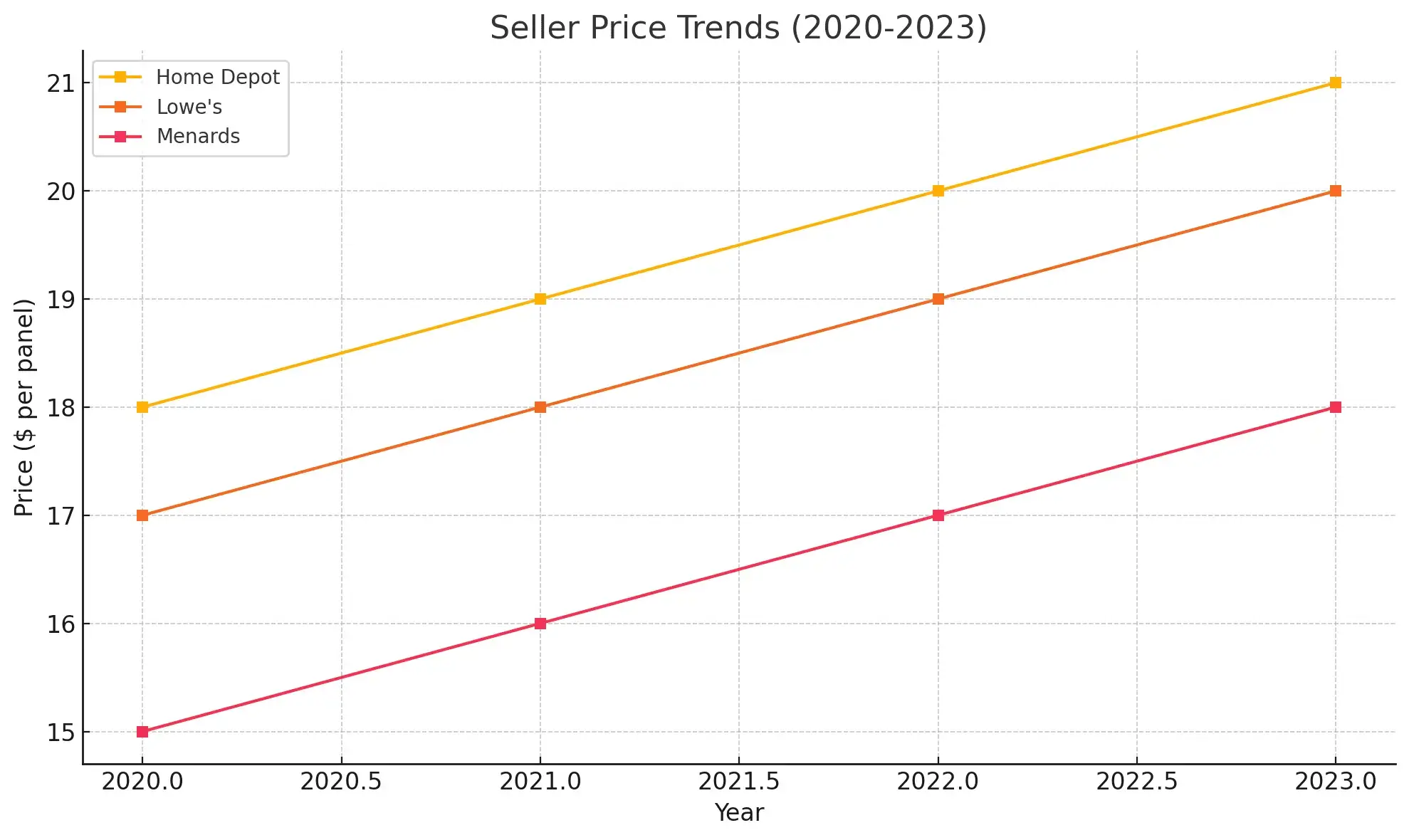
This graph demonstrates price differences between sellers like Home Depot, Lowe’s, and Menards. Home Depot tends to offer drywall at a higher price point than Menards, particularly for premium products like moisture-resistant and fire-resistant drywall. Lowe’s prices are consistently between the two.
Regional Price Differences
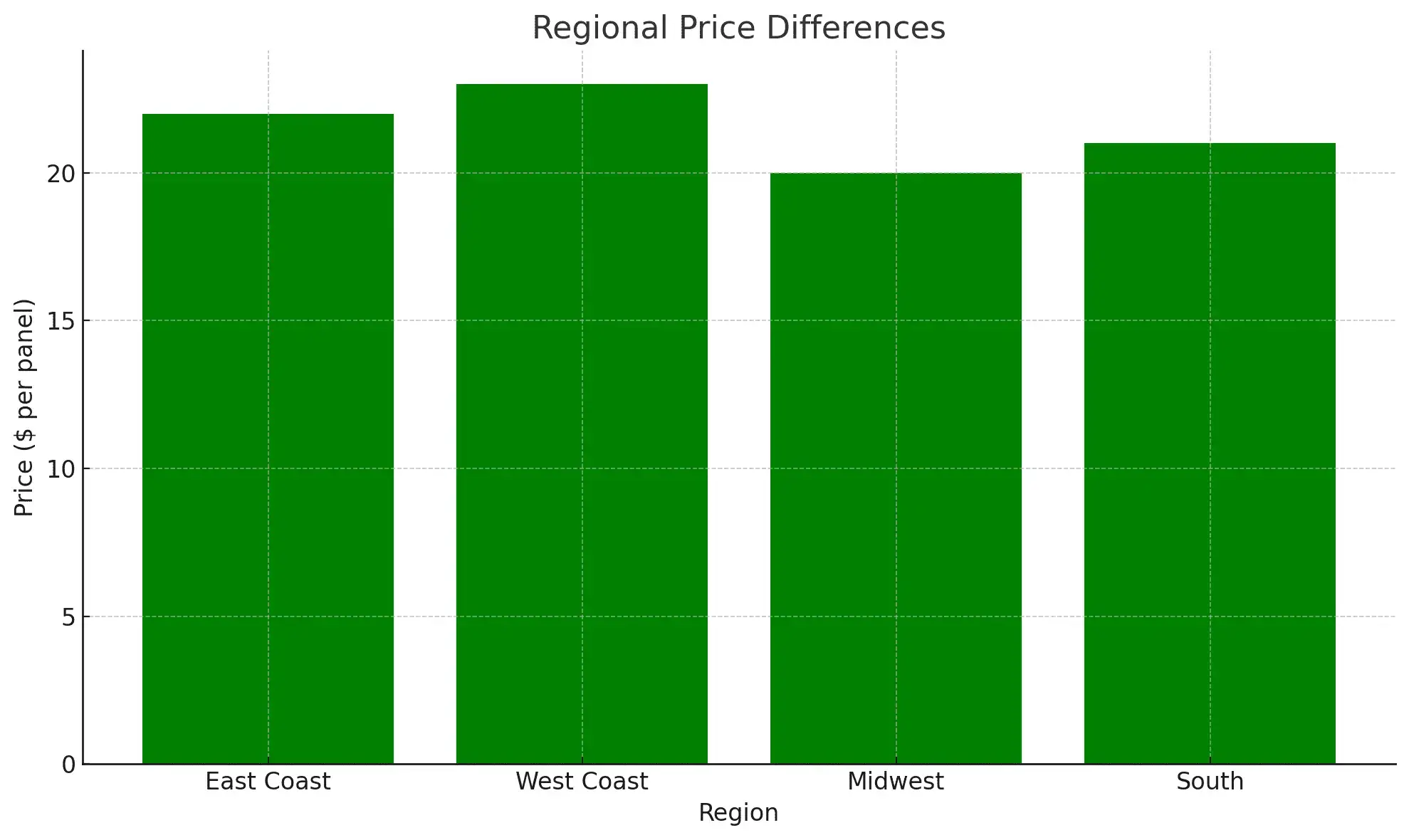
There are regional differences in drywall pricing in the USA, driven by factors such as transportation costs, demand fluctuations, and regional building codes. For example, drywall prices tend to be higher on the East and West Coasts compared to the Midwest.
Seasonal Price Changes
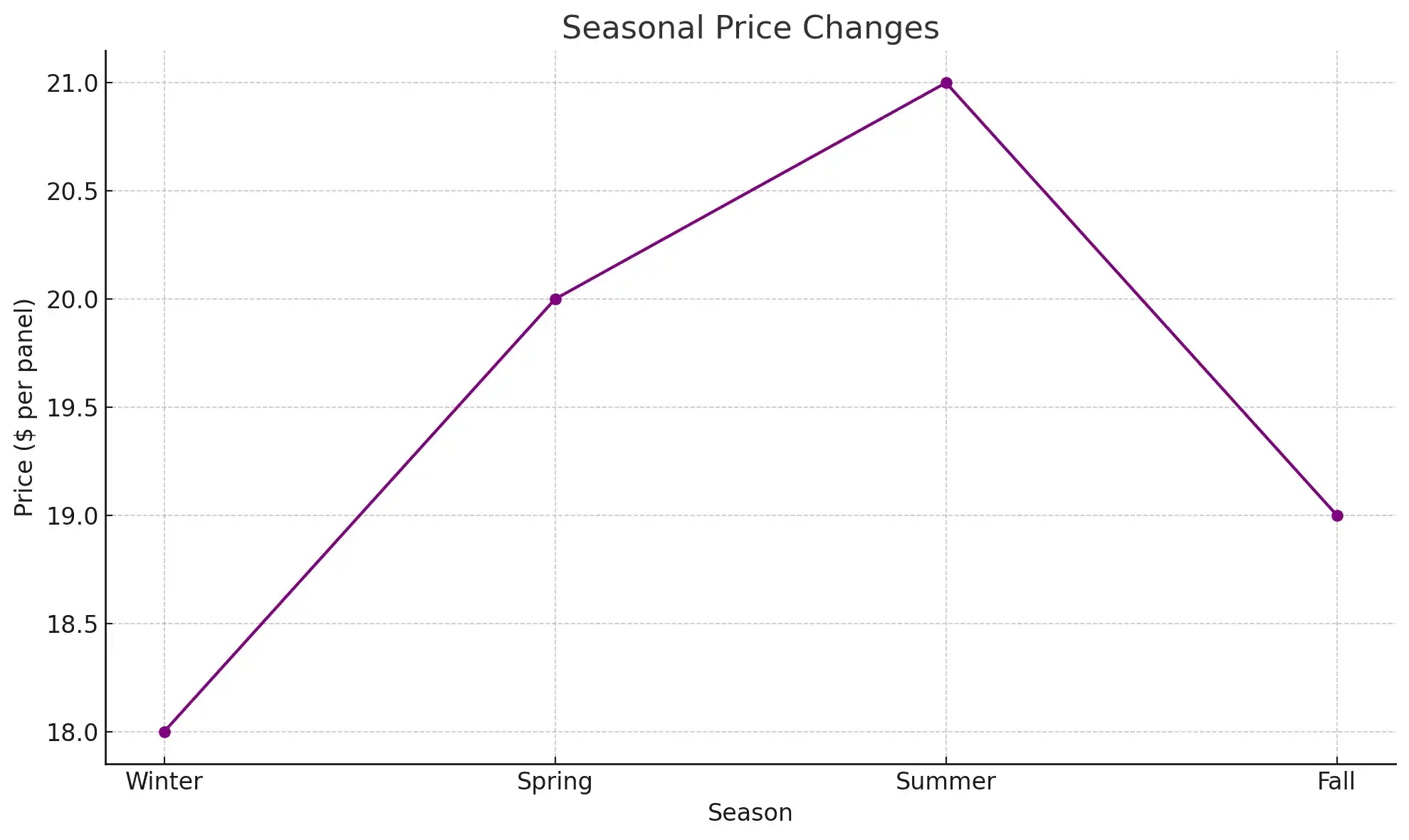
This graph depicts the seasonal variations in drywall pricing. Prices typically increase during the spring and summer months, driven by peak construction season. However, they tend to drop slightly during winter months when construction slows down.
- Price Distribution by Drywall Type: Shows the price range (minimum and maximum) for each type of drywall, comparing standard, moisture-resistant, fire-resistant, soundproof, and eco-friendly drywall.
- Manufacturer Price Trends (2020-2023) indicate a rise in drywall installation costs. Highlights the price changes over time for major manufacturers, including USG Corporation, National Gypsum, CertainTeed, and Georgia-Pacific.
- Seller Price Trends (2020-2023): Compares the price trends of major drywall sellers such as Home Depot, Lowe’s, and Menards over the last few years.
- Regional Price Differences: Illustrates the price variations in different regions of the USA, including the East Coast, West Coast, Midwest, and South.
- Seasonal Price Changes: The cost to texture drywall can vary significantly depending on the time of year and market demand. Shows how drywall prices change across different seasons, reflecting higher demand and prices during spring and summer.
These visualizations help in understanding the drywall market in a clearer and more structured manner.
Market Trends and Future Projections
Historical Price Trends (2019–2023)
The cost of drywall has seen notable fluctuations in the last five years. In 2020, the prices spiked due to supply chain disruptions caused by the COVID-19 pandemic, resulting in drywall costs rising between 10% and 20%. This trend continued into 2021, as demand remained high due to an increase in home renovations and new construction projects. By 2022, the price growth stabilized but remained above pre-pandemic levels. In 2023, drywall prices moderated slightly as supply chains improved.
Production and Supply Analysis
Drywall production in the USA is expected to increase steadily through 2024, with projected growth in the range of 2-3% annually. This increase in production is driven by continued demand in residential and commercial construction. However, rising labor costs and material shortages could temper the speed of recovery, which will likely keep drywall prices elevated compared to pre-2020 levels.
Sales and Demand Trends
In 2023, the USA construction industry showed resilience despite economic headwinds. The demand for drywall has been particularly strong in regions experiencing population growth, such as the southern and western states. Demand for specialty products like fire-resistant and moisture-resistant drywall continues to grow, reflecting stricter building regulations and consumer preferences for safety and sustainability.
Popularity and Market Share
Standard drywall remains the most commonly used product, but its market share is decreasing as builders and consumers increasingly opt for moisture-resistant and fire-resistant options. Soundproof drywall is also becoming more popular, particularly in multi-family residential and office construction projects.
Future Projections (2024–2027)
The drywall market is expected to grow moderately over the next five years, with price increases driven by higher production costs and increased demand for sustainable and specialized products. Eco-friendly drywall, while still niche, is projected to experience growth as green building practices become more prevalent. Additionally, advancements in drywall technology, such as enhanced fire resistance and soundproofing, may also influence future pricing.
Conclusion
In summary, the drywall market in the USA is dynamic and influenced by multiple factors, including product type, manufacturer pricing strategies, seller distribution networks, and regional demand for fire-resistant drywall and soundproof drywall per square foot. This article provided a detailed analysis of drywall price trends, covering both wholesale and retail pricing, manufacturer and seller comparisons, as well as an examination of historical trends and future projections.
The key insights from this article can be summarized as follows:
- Price Trends: Drywall prices have seen significant increases since 2020, though they are expected to stabilize in the coming years.
- Types of Drywall: Standard drywall remains the most popular, but there is growing demand for specialized products such as moisture-resistant, fire-resistant, and soundproof drywall.
- Manufacturers and Sellers: USG Corporation, National Gypsum, and CertainTeed are the leading drywall manufacturers, while Home Depot, Lowe’s, and Menards dominate the retail market.
- Market Dynamics: The interplay of supply and demand influences the cost of drywall installation and the pricing strategies of manufacturers. Factors such as production costs, supply chain disruptions, and demand for sustainable products will continue to shape the drywall market in the coming years.
For contractors, builders, and homeowners, understanding these trends will help in making informed purchasing decisions. By considering the type of drywall needed, pricing variations across manufacturers and sellers, and regional price differences, consumers can optimize their purchases, especially when planning large-scale projects.
As the market continues to evolve, staying informed about price trends, market dynamics, and emerging products will be critical for making strategic decisions.
Drywall Pricing Analysis
Wholesale and Retail Prices by Drywall Type
| Drywall Type | Wholesale Price ($) | Retail Price ($) |
|---|---|---|
| Standard | 12 | 20 |
| Moisture-Resistant | 15 | 25 |
| Fire-Resistant | 20 | 30 |
| Soundproof | 30 | 60 |
| Eco-Friendly | 15 | 25 |
Price Comparison Among Top Manufacturers
| Manufacturer | Standard Drywall ($) | Moisture-Resistant Drywall ($) | Fire-Resistant Drywall ($) | Soundproof Drywall ($) |
|---|---|---|---|---|
| USG Corporation | 15 | 18 | 23 | 50 |
| National Gypsum | 14 | 17 | 22 | 48 |
| CertainTeed | 13 | 16 | 20 | 45 |
| Georgia-Pacific | 12 | 14 | 19 | 40 |
Price Comparison Among Top Sellers
| Seller | Standard Drywall ($) | Moisture-Resistant Drywall ($) | Fire-Resistant Drywall ($) | Soundproof Drywall ($) |
|---|---|---|---|---|
| Home Depot | 18 | 22 | 28 | 55 |
| Lowe’s | 17 | 21 | 27 | 50 |
| Menards | 15 | 18 | 26 | 45 |
Regional Price Variations within the USA
| Region | Standard Drywall ($) | Moisture-Resistant Drywall ($) | Fire-Resistant Drywall ($) |
|---|---|---|---|
| East Coast | 22 | 25 | 30 |
| West Coast | 23 | 26 | 31 |
| Midwest | 20 | 22 | 27 |
| South | 21 | 23 | 28 |
Seasonal Price Fluctuations
| Season | Price for Standard Drywall ($) | Price for Moisture-Resistant Drywall ($) |
|---|---|---|
| Winter | 18 | 22 |
| Spring | 20 | 24 |
| Summer | 21 | 25 |
| Fall | 19 | 23 |
Analytical drywall price chart for the years 2025 and 2026
Price Chart Projections for Standard Drywall (2025-2026)
Shows the projected price increase for standard drywall.

Price Projections for Moisture-Resistant Drywall (2025-2026)
Displays projected price trends for moisture-resistant drywall.
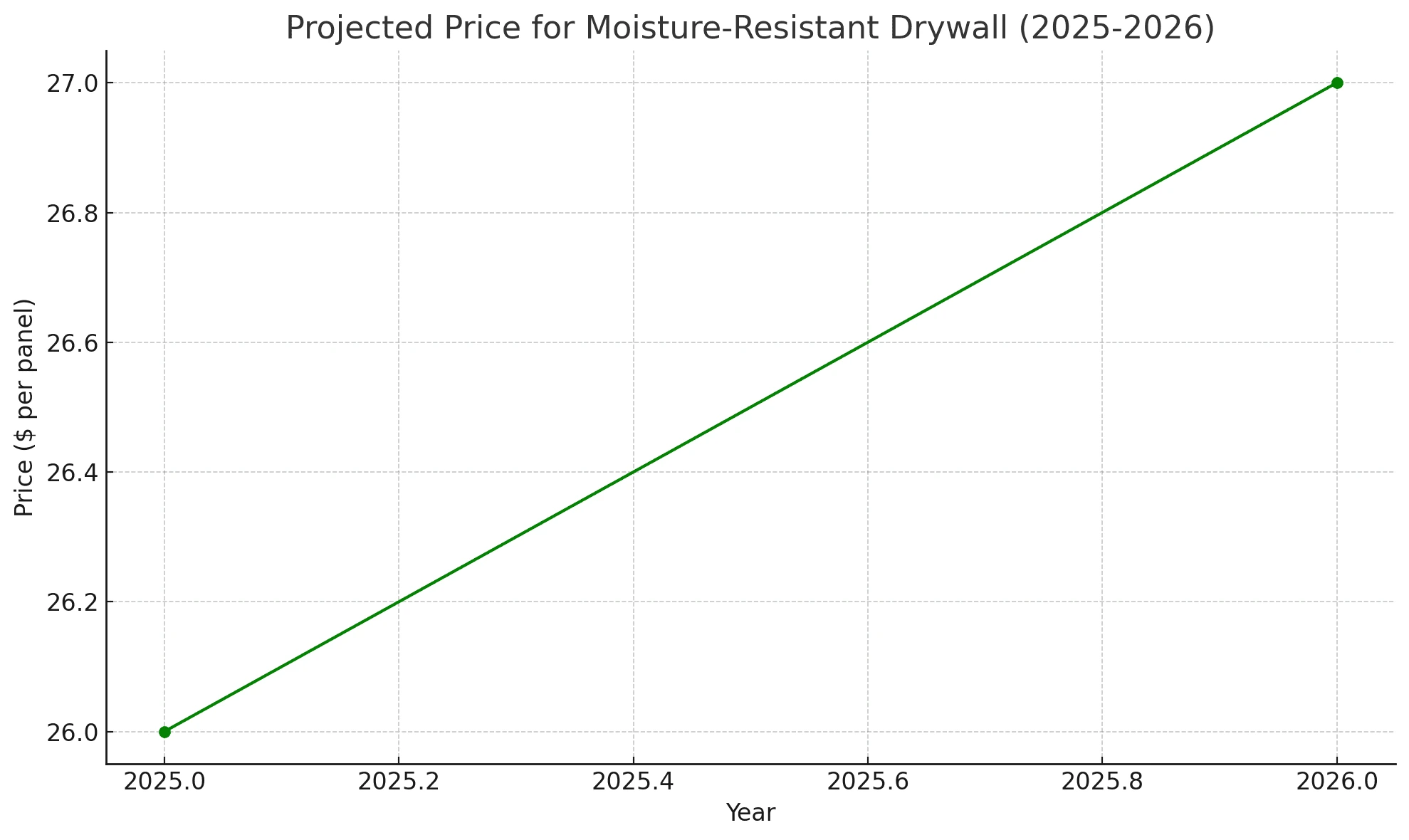
Price Projections for Fire-Resistant Drywall (2025-2026)
Highlights the projected price growth for fire-resistant drywall.
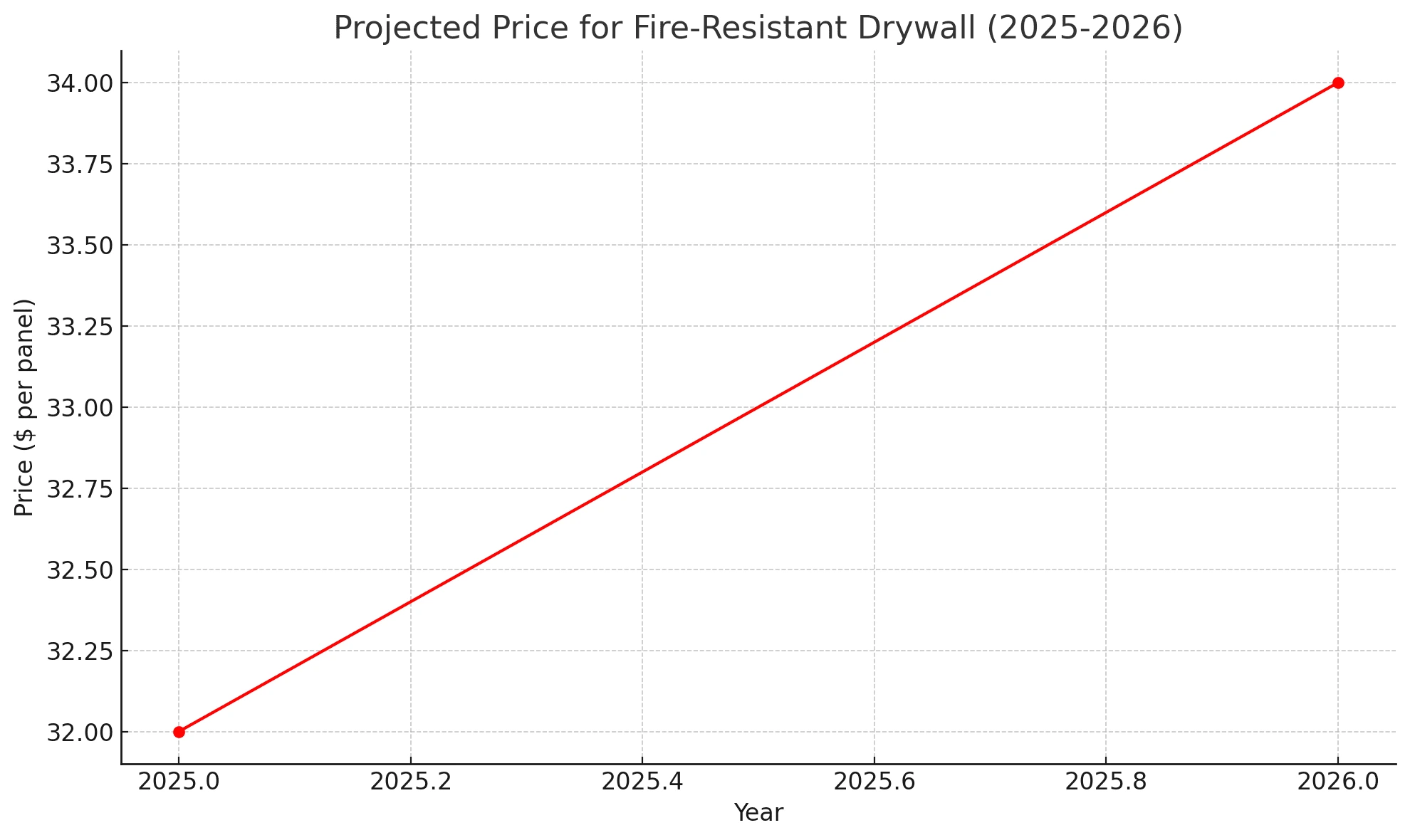
Comparative Projected Prices for Different Drywall Types (2025-2026)
Compares price projections for standard, moisture-resistant, and fire-resistant drywall.

Regional Price Variations (Projected 2025-2026)
Projects how drywall prices will vary by region (East Coast, West Coast, Midwest, and South).

Seasonal Price Changes for Standard Drywall (2025-2026)
Projects seasonal price fluctuations for standard drywall across winter, spring, summer, and fall.
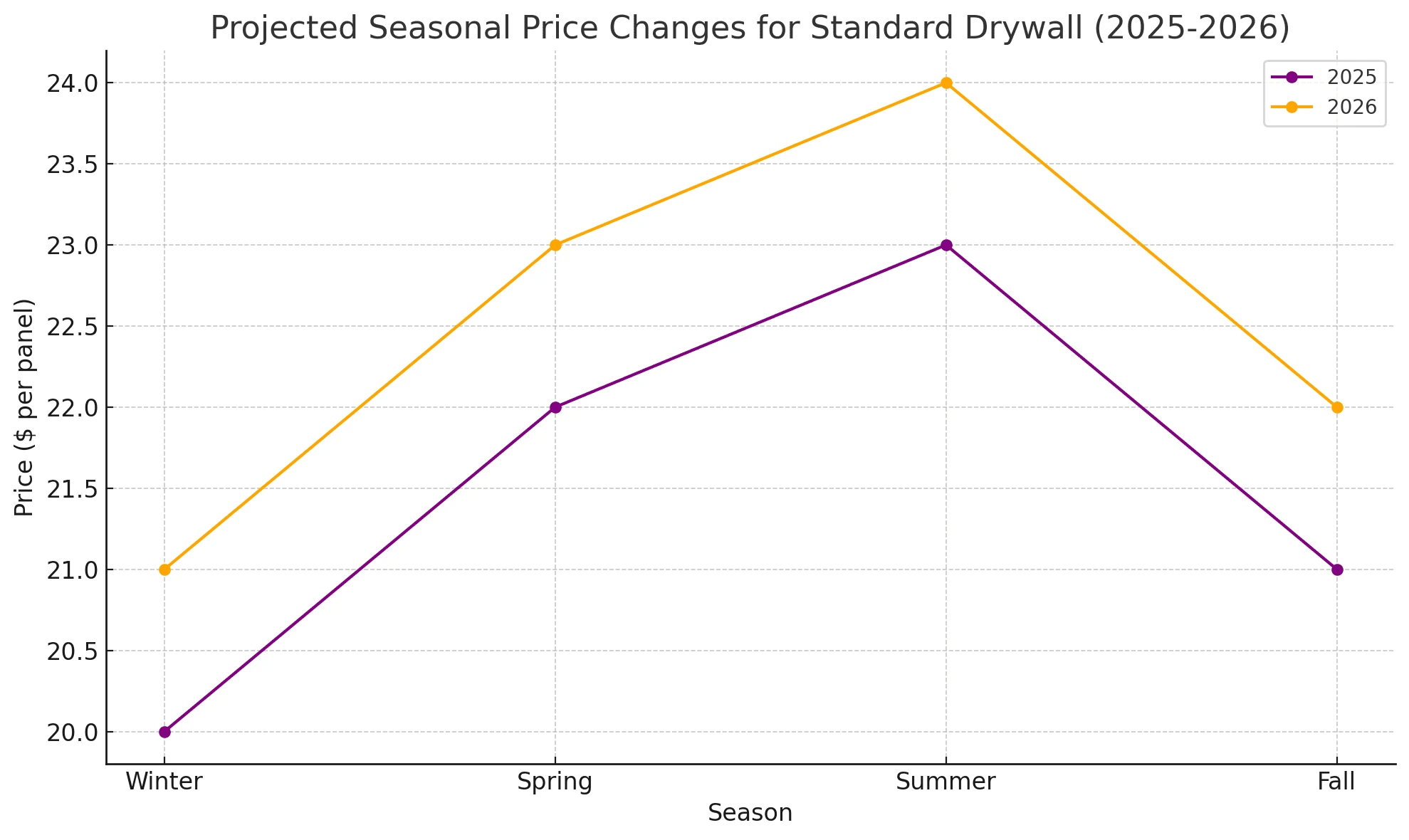
These drywall price charts offer valuable insights into how prices for various drywall types and regions are expected to evolve in the near future.
Analytical drywall price chart for the years 2024 and 2025
Projected Price Growth for Fire-Resistant Drywall (2024-2025)
Displays the projected price increase for fire-resistant drywall panels.

Projected Drywall Installation Labor Costs (2024-2025)
Shows expected labor cost changes for drywall installation over 2024 and 2025.
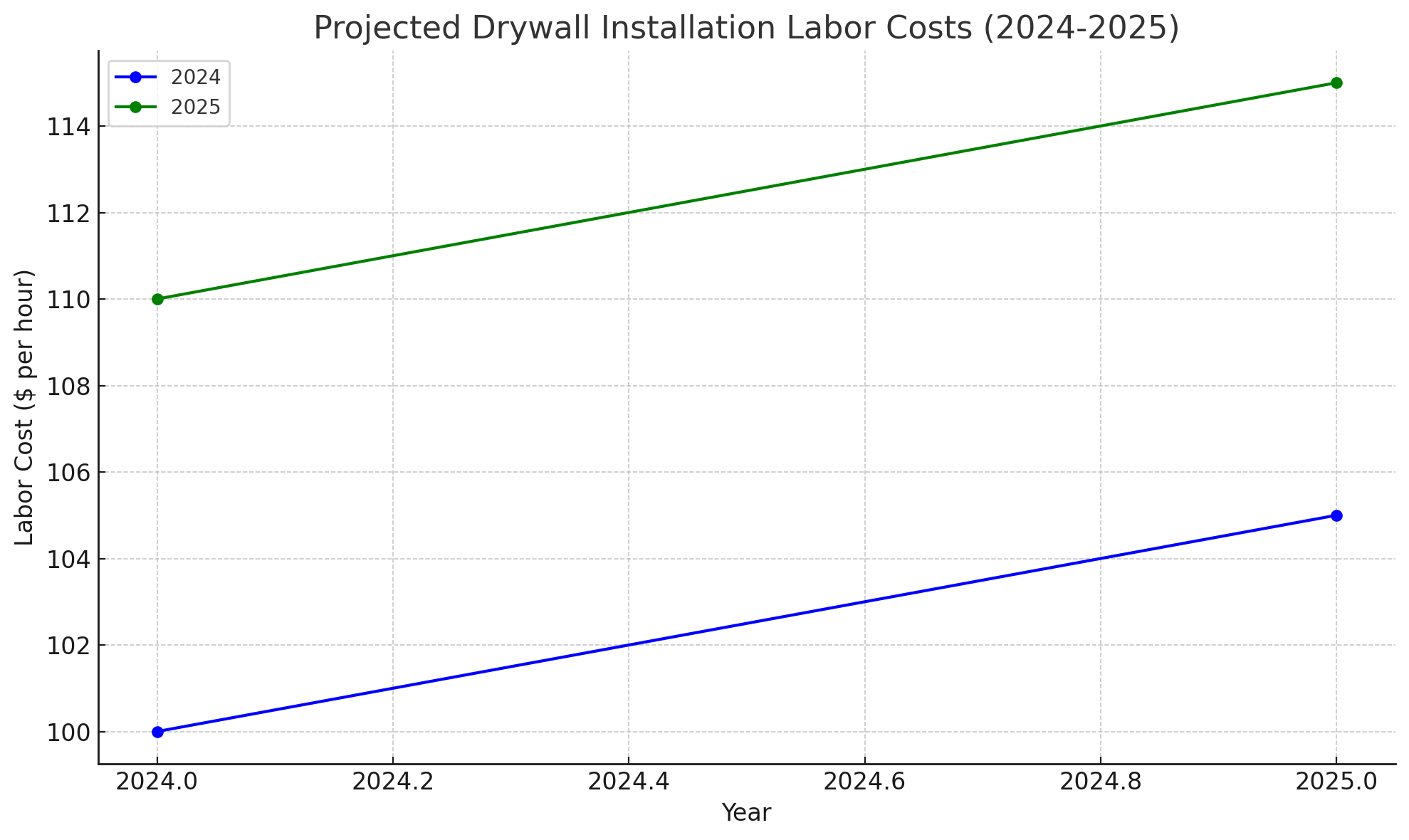
Projected Price Fluctuations for Soundproof Drywall (2024-2025)
Highlights the expected price changes for soundproof drywall.
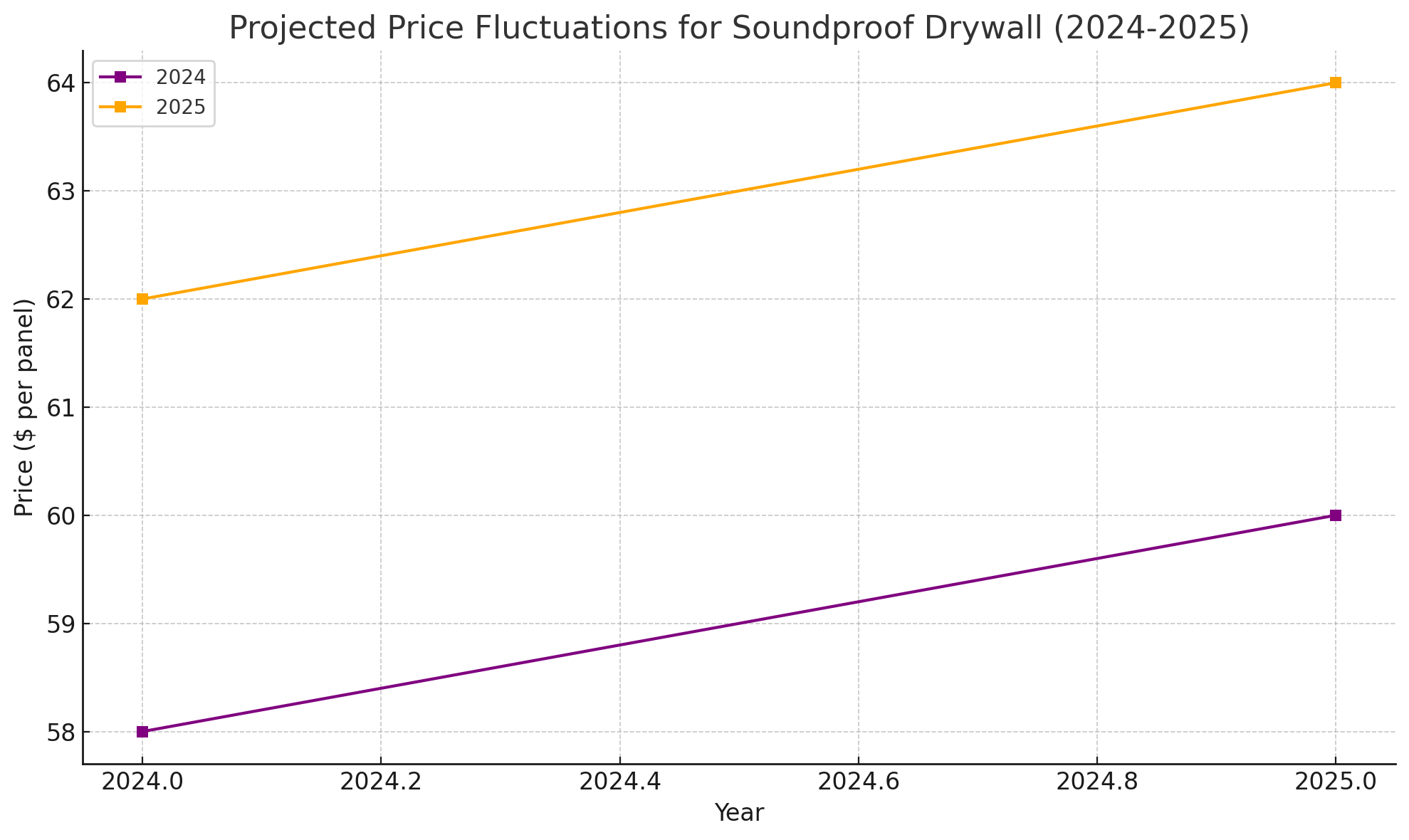
Projected Commercial Demand for Moisture-Resistant Drywall (2024-2025)
Demonstrates the anticipated demand for moisture-resistant drywall in the commercial sector.
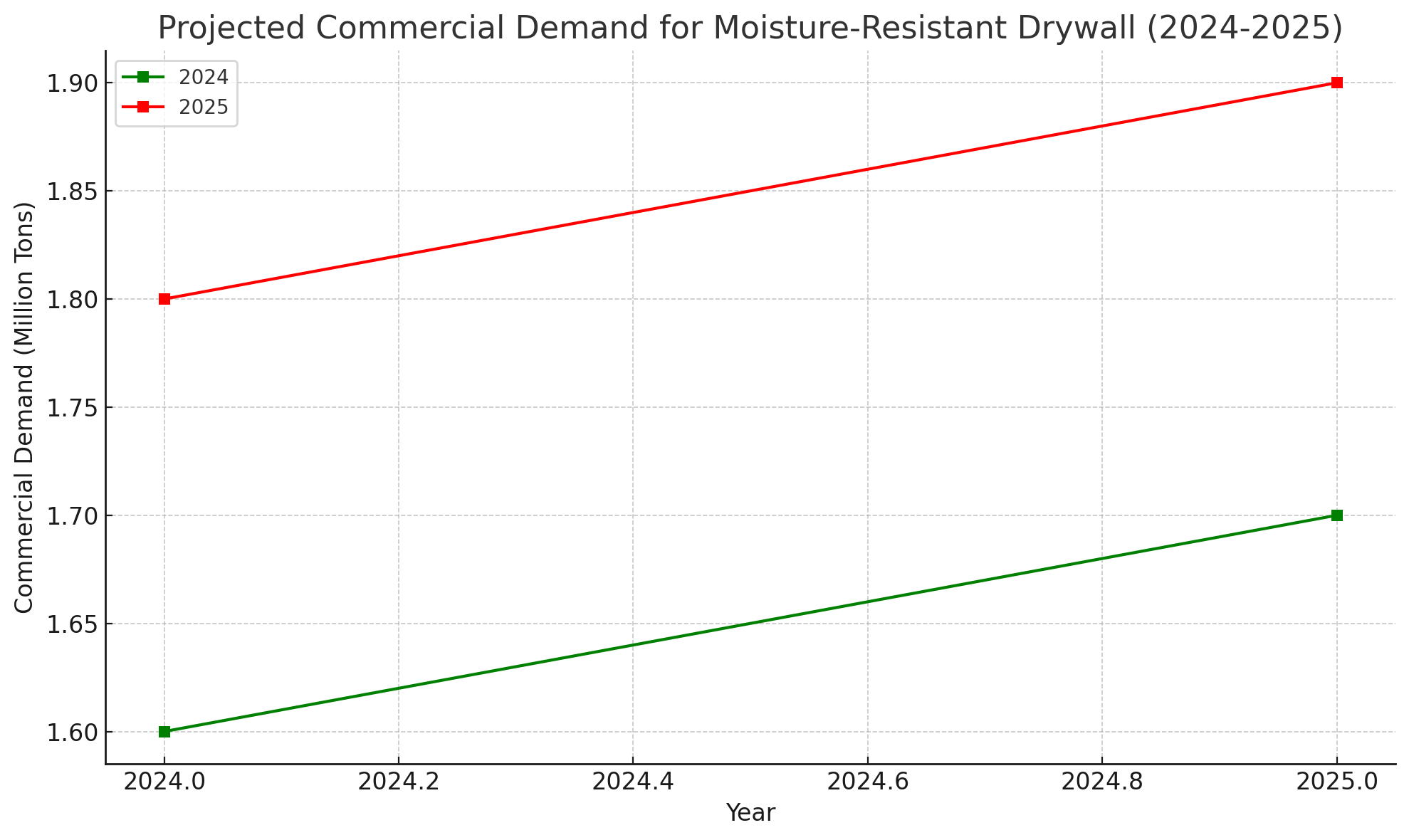
Projected Seasonal Price Fluctuations for Drywall (2024-2025)
Reflects seasonal price changes for drywall across different seasons for the years 2024 and 2025.
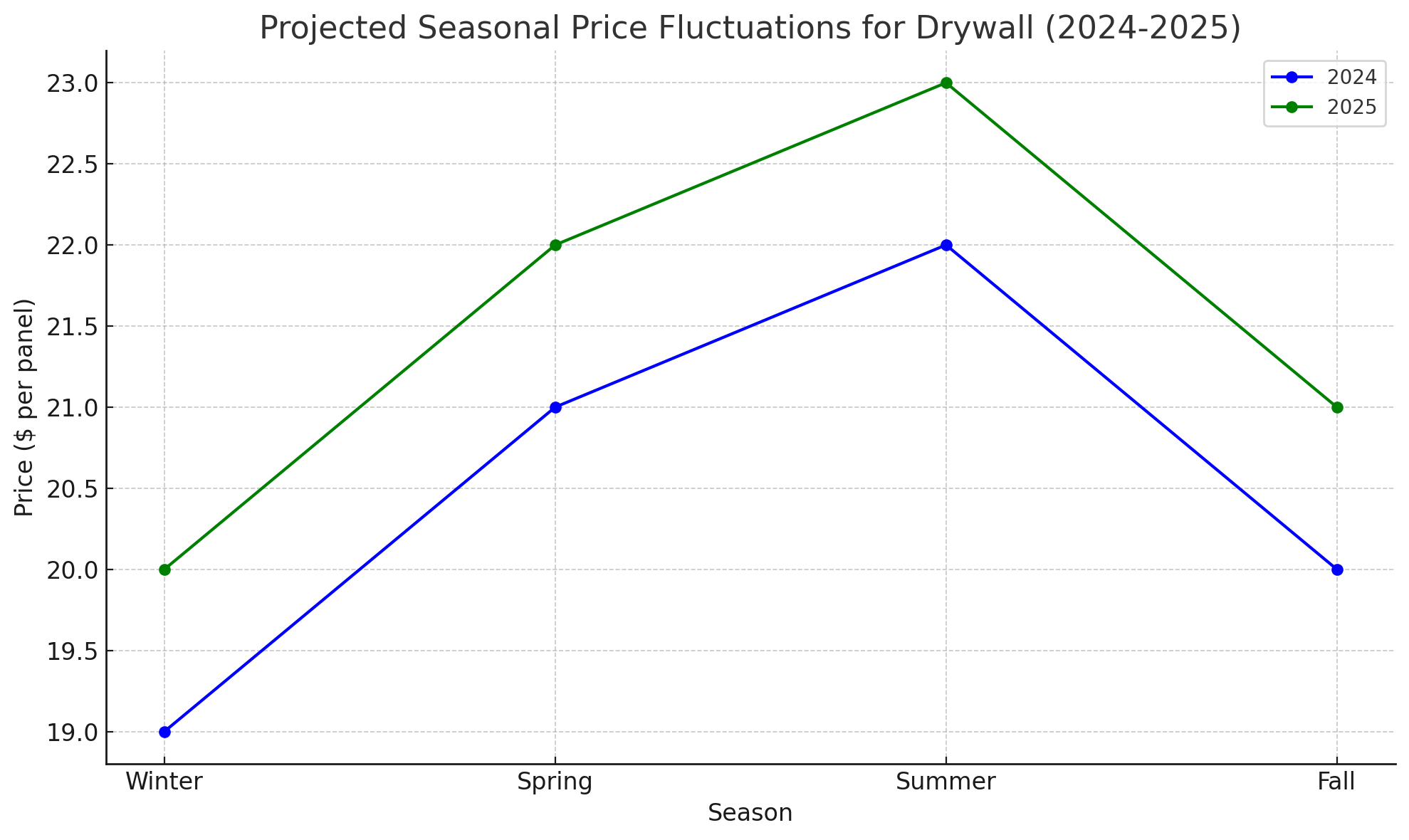
Projected Residential Demand for Drywall (2024-2025)
Shows the projected growth in residential drywall demand over the next two years.
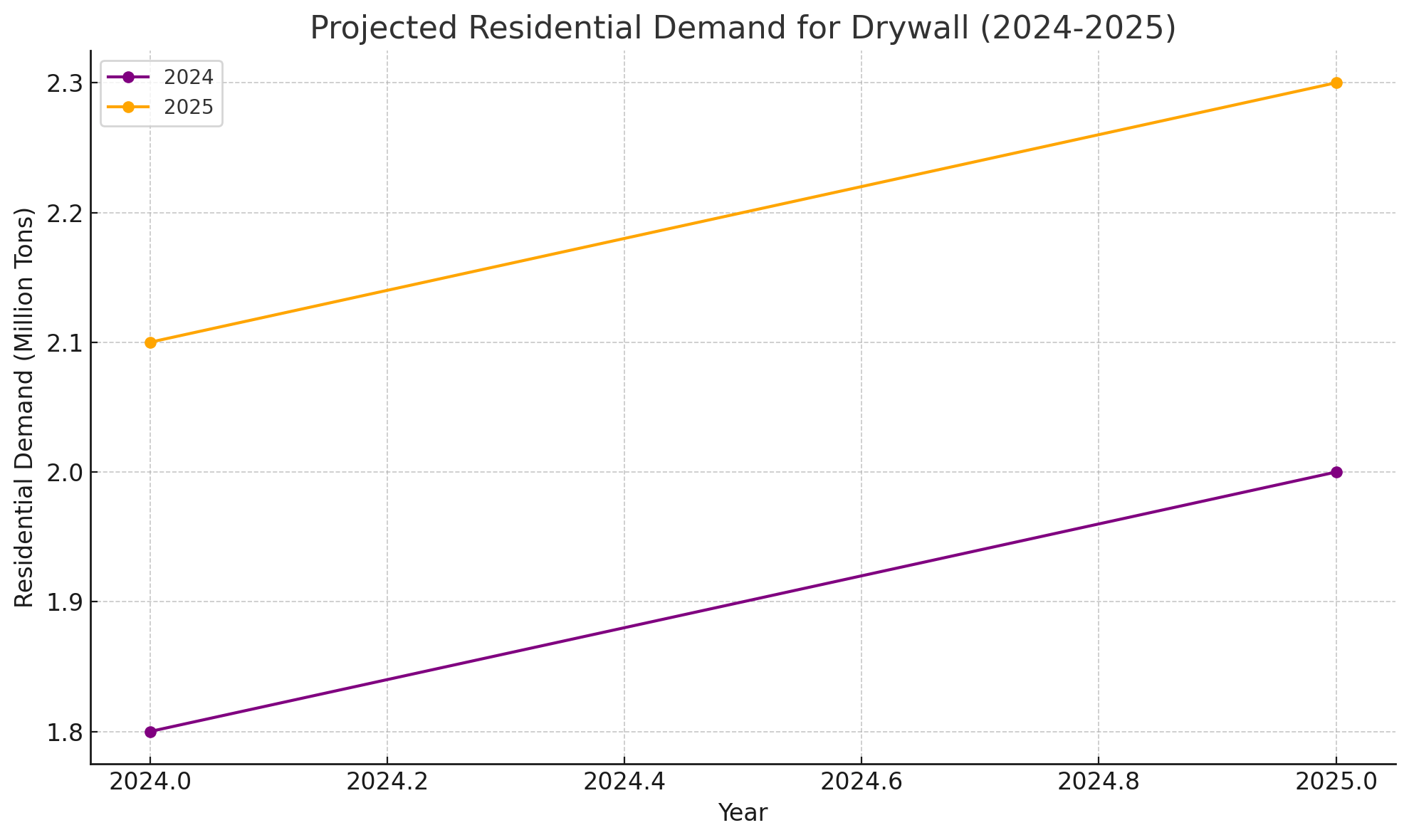
These drywall price charts provide further insight into how drywall prices and demand are expected to evolve in various sectors and conditions.
Projected Price Growth for Eco-Friendly Drywall (2024-2025)
Shows the projected price increase for eco-friendly drywall panels over the two years.
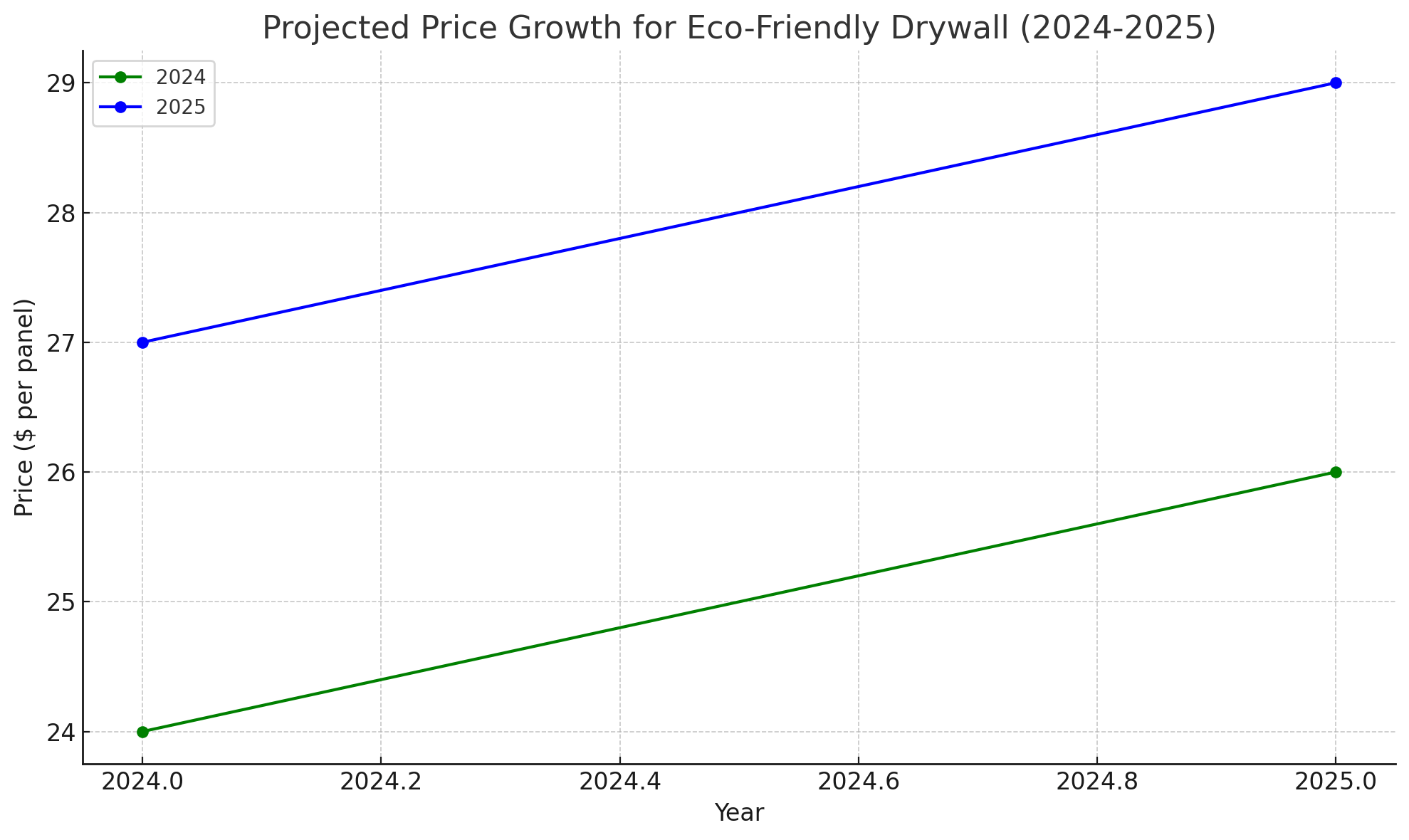
Projected Wholesale vs Retail Price Gap (2024-2025)
Compares projected wholesale and retail price trends for drywall.
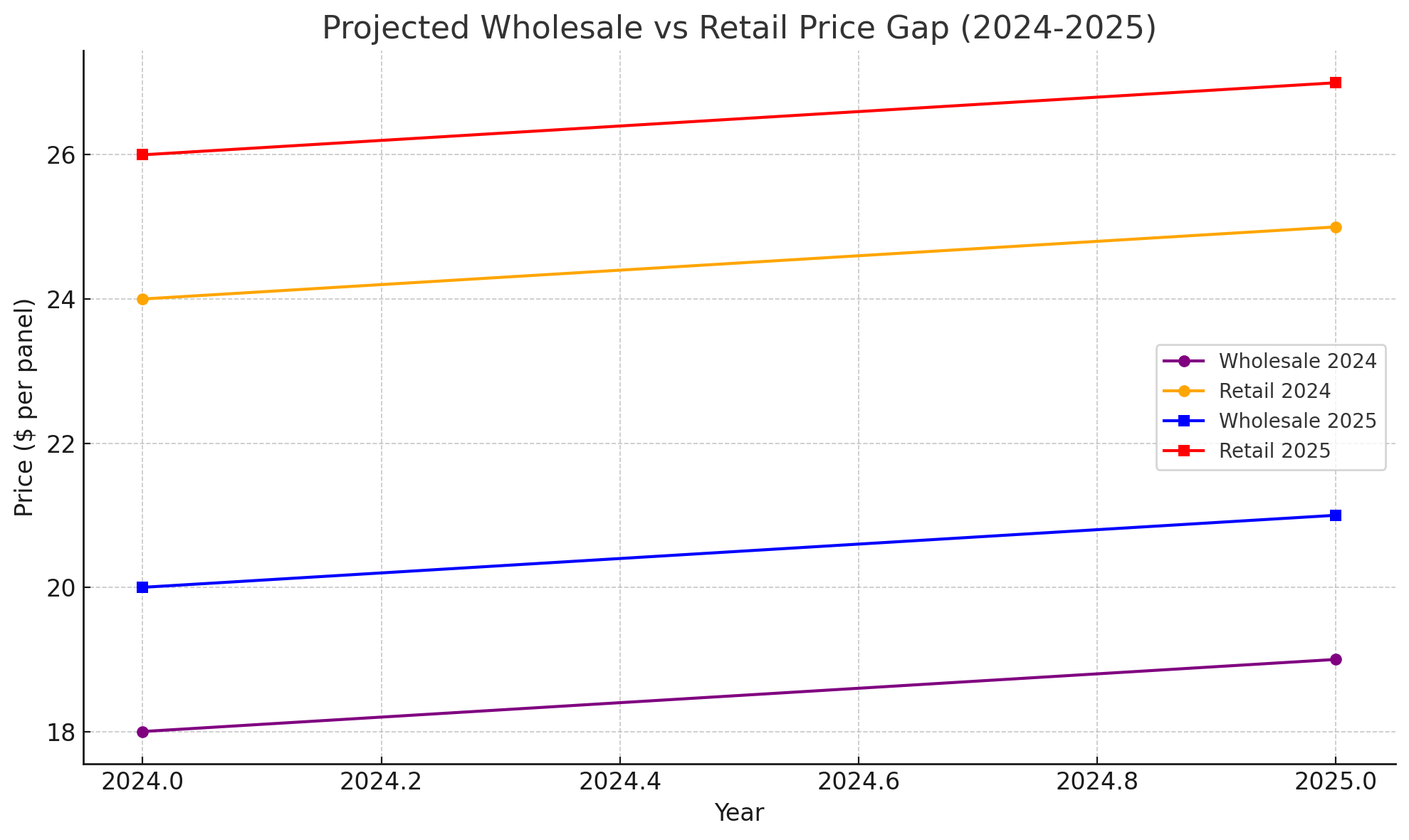
Projected Residential vs Commercial Demand for Drywall (2024-2025)
Compares drywall demand between residential and commercial sectors.
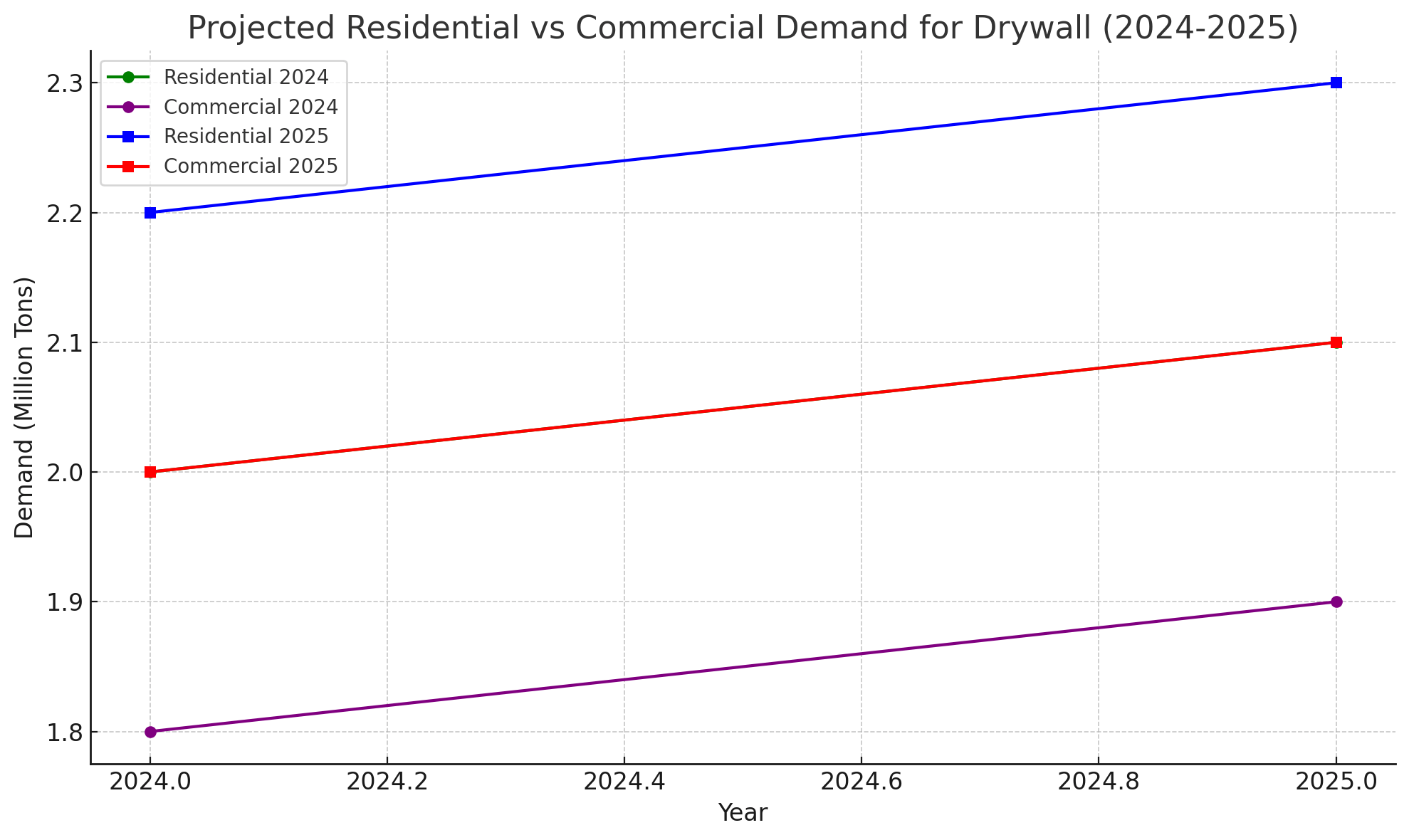
Projected Regional Price Variations for Drywall (2024-2025)
Highlights the price differences across regions such as the East Coast, West Coast, Midwest, and South.

Projected Labor Cost for Drywall Installation (2024-2025)
Shows the expected increase in labor costs for drywall installation.

Projected Seasonal Price Changes for Drywall (2024-2025)
Reflects projected seasonal price fluctuations, comparing winter and summer prices for drywall in 2024 and 2025.
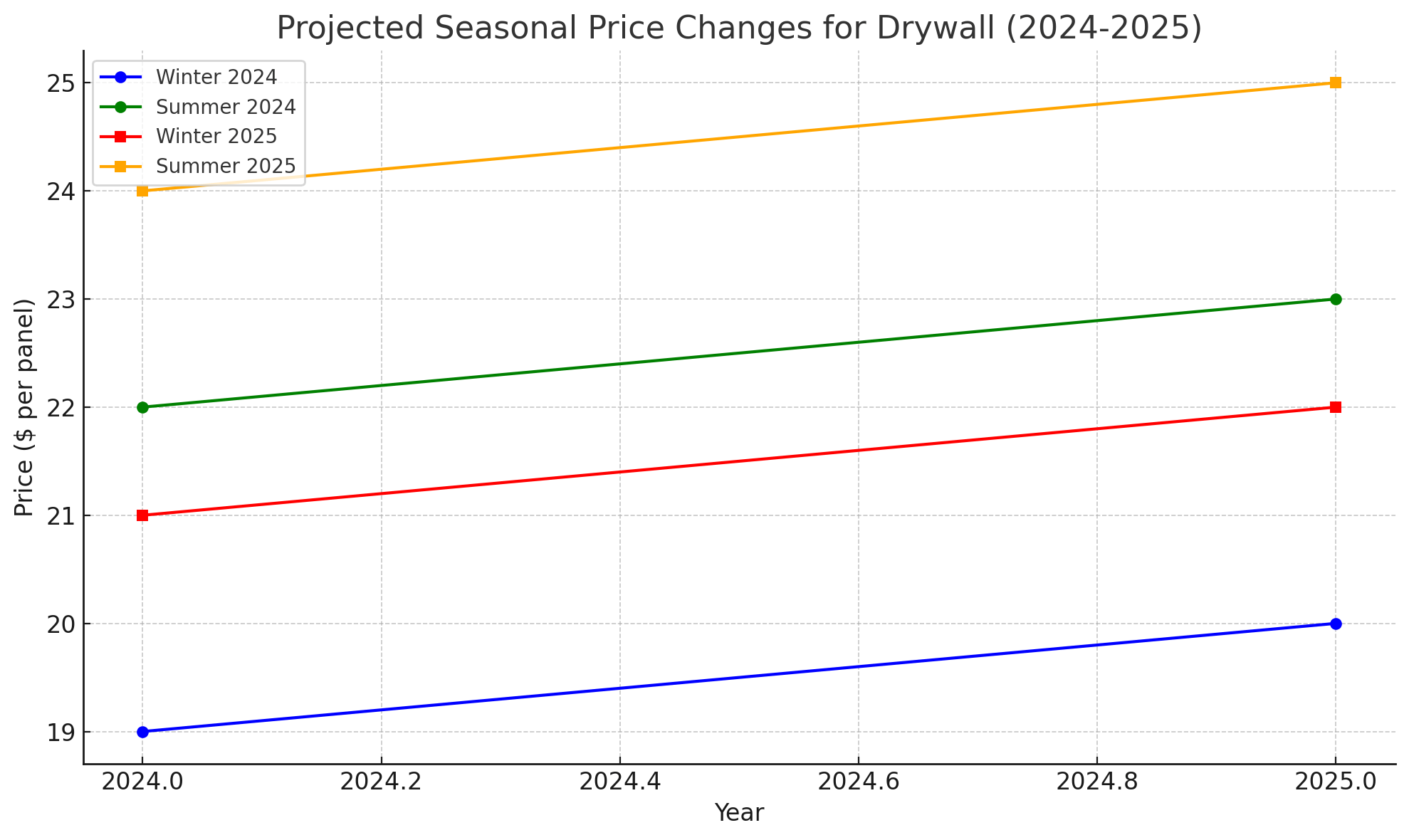
These drywall price charts provide deeper insights into the future of drywall pricing, demand, and regional variations.
Yes, projecting drywall prices further into the future involves considering several factors that influence the market, such as:
Factors Affecting Future Drywall Prices
- Supply Chain Stability: Fluctuations in material availability (such as gypsum and paper), transportation costs, and labor shortages.
- Construction Demand: Economic factors driving construction in both residential and commercial sectors, especially after 2025.
- Technological Advancements: New developments in eco-friendly and energy-efficient drywall materials could push prices up.
- Inflation and Labor Costs: Inflationary pressures and increased labor costs will continue to affect drywall installation and manufacturing prices.
- Regulatory Changes: Building codes or environmental regulations could increase demand for specialized drywall (e.g., fire-resistant, moisture-resistant).
Projected Price Ranges (2026-2030)
| Year | Standard Drywall Price ($ per panel) | Moisture-Resistant Drywall ($ per panel) | Fire-Resistant Drywall ($ per panel) |
|---|---|---|---|
| 2026 | 22-24 | 27-29 | 36-38 |
| 2027 | 24-26 | 29-31 | 38-40 |
| 2028 | 26-28 | 30-33 | 40-42 |
| 2029 | 27-29 | 32-34 | 42-44 |
| 2030 | 28-30 | 34-36 | 44-46 |
Here’s what we’re keeping an eye on in 2025
- Adoption of Green Building Materials: As demand for eco-friendly building materials grows, manufacturers may increase the production of eco-friendly drywall, which could come at a premium.
- Construction Booms in Key Regions: Highlights the cost to finish drywall in key regions. Population growth and urbanization trends in the South and West could lead to spikes in demand and price fluctuations.
- Global Supply Chain Changes: If supply chains become more localized, drywall production costs may decrease, which could moderate price increases.
Final Thoughts on Future Projections
While the projected prices are estimates, it’s important to monitor factors like government infrastructure spending, technological developments, and market disruptions to refine these predictions. By continuously tracking demand, labor costs, and materials, more accurate predictions can be made.

